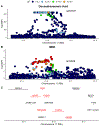Metabolomic Investigation of Major Depressive Disorder Identifies a Potentially Causal Association With Polyunsaturated Fatty Acids
- PMID: 36764567
- PMCID: PMC10804990
- DOI: 10.1016/j.biopsych.2023.01.027
Metabolomic Investigation of Major Depressive Disorder Identifies a Potentially Causal Association With Polyunsaturated Fatty Acids
Erratum in
-
Erratum.Biol Psychiatry. 2024 Jan 1;95(1):93. doi: 10.1016/j.biopsych.2023.10.001. Biol Psychiatry. 2024. PMID: 38030308 No abstract available.
Abstract
Background: Metabolic differences have been reported between individuals with and without major depressive disorder (MDD), but their consistency and causal relevance have been unclear.
Methods: We conducted a metabolome-wide association study of MDD with 249 metabolomic measures available in the UK Biobank (n = 29,757). We then applied two-sample bidirectional Mendelian randomization and colocalization analysis to identify potentially causal relationships between each metabolite and MDD.
Results: A total of 191 metabolites tested were significantly associated with MDD (false discovery rate-corrected p < .05), which decreased to 129 after adjustment for likely confounders. Lower abundance of omega-3 fatty acid measures and a higher omega-6 to omega-3 ratio showed potentially causal effects on liability to MDD. There was no evidence of a causal effect of MDD on metabolite levels. Furthermore, genetic signals associated with docosahexaenoic acid colocalized with loci associated with MDD within the fatty acid desaturase gene cluster. Post hoc Mendelian randomization of gene-transcript abundance within the fatty acid desaturase cluster demonstrated a potentially causal association with MDD. In contrast, colocalization analysis did not suggest a single causal variant for both transcript abundance and MDD liability, but rather the likely existence of two variants in linkage disequilibrium with one another.
Conclusions: Our findings suggest that decreased docosahexaenoic acid and increased omega-6 to omega-3 fatty acids ratio may be causally related to MDD. These findings provide further support for the causal involvement of fatty acids in MDD.
Keywords: Colocalization; Depression; Fatty acids; Mendelian randomization; Metabolome; Multiomics.
Copyright © 2023 Society of Biological Psychiatry. Published by Elsevier Inc. All rights reserved.
Conflict of interest statement
Disclosures
Required financial disclosures and conflict of interest statements for each author.
Figures



References
-
- GBD 2017 Dis Injury Incidence Pr, James SLG, Abate D, Abate KH, Abay SM, Abbafati C, et al. Global, regional, and national incidence, prevalence, and years lived with disability for 354 diseases and injuries for 195 countries and territories, 1990-2017: a systematic analysis for the Global Burden of Disease Study 2017. The Lancet. 2018. Nov 10;392(10159):1789–858. - PMC - PubMed
-
- Oladeji BD, Gureje O. The Comorbidity between Depression and Diabetes. Curr Psychiatry Rep. 2013. Aug 11;15(9):390. - PubMed
-
- Nemeroff CB, Goldschmidt-Clermont PJ. Heartache and heartbreak—the link between depression and cardiovascular disease. Nat Rev Cardiol. 2012. Sep;9(9):526–39. - PubMed
-
- Cizza G, Ravn P, Chrousos GP, Gold PW. Depression: a major, unrecognized risk factor for osteoporosis? Trends Endocrinol Metab. 2001. Jul 1;12(5):198–203. - PubMed
Publication types
MeSH terms
Substances
Grants and funding
LinkOut - more resources
Full Text Sources

